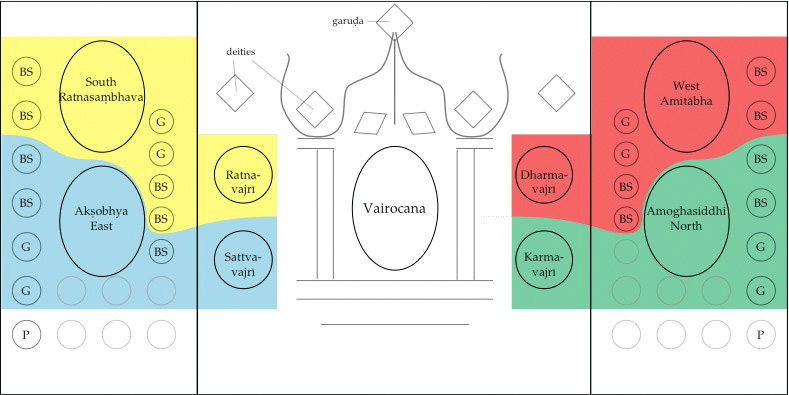
Main Temple
The Main Temple or Tsuklakkhang (གཙུག་ལག་ཁང་) is the largest structure in the center of the monastic complex and includes the Assembly Hall or Dukhang (འདུ་ཁང་). Its front part, including the original veranda of the Dukhang, has been altered soon after the Dukhang's construction. As the in situ survey with architects from the Graz University of Technology has revealed, these alterations include the addition of flanking buildings and the courtyard in a relatively clear chronological sequence.
Dukhang
The Assembly Hall or Dukhang (འདུ་ཁང་) has three structural units, a veranda, a main hall measuring 7.5 x 7.9 meters and a large niche of 3.3 x 2.4 meters in the back-wall. It is also the oldest monument preserved at Alchi, but there is no decisive clue for the temporal interval between this temple and the Sumtsek that dates to around 1220.
In the niche at the back of the temple is a sculptural configuration of Vajradhātu mandala assembly centered on Vairocana (see drawing below and ◊ Alchi Dukhang Sculptures). Below the thousand Buddhas painted to the sides of the niche is a depiction of the Abhirati paradise of the Buddha Akṣobhya together with an excerpt from the Akṣobhyavyūha sutra (◊ Abhirati). Further, walls of the main hall are painted with seven Yoga Tantra mandalas, among them the Dharmadhātu and Sarvavid mandalas. The entrance is flanked by an only partially preserved life of the Buddha (left) and a large depiction dedicated to donors and their feasts (right). Curiously, although the columns, capitals and brackets are original, none of the original ceiling decoration has survived.
The Dukhang also preserves an elaborately carved wooden door frame, while the remaining parts of the veranda, the sides of which are closed up today, have been considerably altered with the addition of the courtyard. This includes the veranda's ceiling the painted textile patterns of which are comparatively crude and likely contemporaneous with the courtyard.
Apse
In the sculptural configuration of the apse a four-headed Buddha Vairocana is flanked by four goddesses and a number of offering deities in clay. The other four esoteric Buddhas are placed on the side walls and have painted secondary images (see drawing below). Today the niche is closed off behind a glass partition and piled high with furniture. All the images lower down and the central Vairocana (particularly the faces) have, at some stage, been repaired and repainted, while the images higher up largely preserved their original form and colouring (◊ Alchi Dukhang Sculptures).
Below Vairocana, a lotus stem emerges from a vase flanked by two snake deities (nāga). As on the main wall of the Lalung Serkhang, this stem not only supports the lotus of the main image but develops into a scroll that also frames all the secondary images on the main wall of the niche. The delicacy of the scroll as well as the frames of the main images, all preserving much of their original painting, contrasts with the sturdy build of the figures. The sculptural configuration of the niche is complemented by deities painted on the side walls flanking the four esoteric Buddhas. Although only a part of the figures is visible today, the lower ones now being concealed by the furniture, it is clear that they belong iconographically to the sculptures.

Sculptural configuration in the niche of the Alchi Main Temple.
- Luczanits, Christian. Buddhist Sculpture in Clay: Early Western Himalayan Art, Late 10th to Early 13th Centuries. Chicago: Serindia, 2004.
The Alchi pages are dedicated to Roger Goepper and his pioneerings studies on the most important Alchi monuments.
